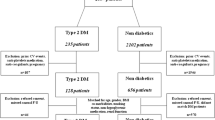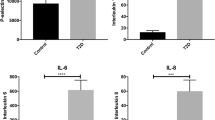Abstract
Coronary heart disease (CHD) and diabetes mellitus (DM) have high reactivity of platelets and an increased risk of thrombosis. Platelet glycosylation is closely related to platelet function and survival. However, the alteration of platelet glycosylation in CHD and T2DM still remains unknown. Platelet samples were obtained from 55 healthy controls and 102 patients, including 33 CHD, 30 T2DM and 39 CHD complicated with T2DM (CHD + T2DM). Platelet glycosylation was detected using eight-lectin based assay by flow cytometry. Platelet activation markers, such as CD62P (P-Selectin) and activated integrin GPIIb/IIIa (PAC-1), were measured on resting and stimulated conditions by flow cytometry. Platelet aggregation was measured by light transmission aggregometry. In CHD group, platelet surface weakly expressed β-Gal and 2,6-sialic acid and strongly expressed β-GlcNAc. In T2DM group, lectins binding to platelet of β-Gal, 2,6-sialic acid and α-mannose were decreased, while α1,6-fucose and GlcNAc were increased. There was positive correlation between ConA (specific for α-mannose) and PAC-1 in T2DM patients, while negative correlation in healthy controls. Patterns and levels of platelet glycosylation in CHD + T2DM group are a combination of CHD group and T2DM group, in addition to the level of ECL highly elevated (specific for β-Gal). The level of ConA was significantly correlated with glucose in T2DM group, also correlated with HbA1c in CHD + T2DM. Our findings suggested that platelets decreased in sialylation, galactosylation and mannosylation, and increased in fucosylation and GlcNAcylation in CHD and T2DM patients. The changes of platelet glycosylation may be associated with high platelet reactivity and the increased risk of thrombosis in CHD and T2DM.



Similar content being viewed by others
References
Zhang J, Zhao L, Lv P et al (2015) Association between polymorphisms of platelet membrane glycoprotein Ibα and risk of coronary heart disease in Han Chinese, Henan, China. Int J Clin Exp Patho 8(5):6005–6011
Vijan S, Hayward RA (2004) Pharmacologic lipid-lowering therapy in type 2 diabetes mellitus: background paper for the American College of Physicians. Ann Intern Med 140(8):650–658. doi:10.7326/0003-4819-140-8-200404200-00013
Vazzana N, Ranalli P, Cuccurullo C et al (2012) Diabetes mellitus and thrombosis. Thromb Res 129(3):371–377. doi:10.1016/j.thromres.2011.11.052
Levine GN, Bates ER, Bittl JA et al (2016) 2016 ACC/AHA guideline focused update on duration of dual antiplatelet therapy in patients with coronary artery disease: a report of the American College of Cardiology/American Heart Association Task Force on Clinical Practice Guidelines. Circulation 134(10):e123-155. doi:10.1161/CIR.0000000000000404
Wang Y, Jobe SM, Ding X et al (2012) Platelet biogenesis and functions require correct protein O-glycosylation. Proc Nat Acad Sci USA 109(40):16143–16148. doi:10.1073/pnas.1208253109
Tsuji T, Tsunehisa S, Watanabe Y et al (1983) The carbohydrate moiety of human-platelet glycocalicin—the structure of the major Ser Thr-linked sugar chain. J Biol Chem 258(10):6335–6339. doi:10.1093/oxfordjournals.jbchem.a121897
Carew JA, Quinn SM, Stoddart JH et al (1992) O-linked carbohydrate of recombinant von Willebrand factor influences ristocetin-induced binding to platelet glycoprotein 1b. J Clin Invest 90(6):2258–2267. doi:10.1172/JCI116112
Schulte am Esch J, 2nd, Robson SC, Knoefel WT et al. (2005) Impact of O-linked glycosylation of the VWF-A1-domain flanking regions on platelet interaction. J Biol Chem 128 (1):82–90. doi:10.1111/j.1365-2141.2004.05253.x
de la Morena-Barrio ME, Di Michele M, Lozano ML et al (2014) Proteomic analysis of platelet N-glycoproteins in PMM2-CDG patients. Thromb Res 133(3):412–417. doi:10.1016/j.thromres.2013.12.024
Michelson AD (2005) Platelet function testing in cardiovascular diseases. Hematology. doi:10.1080/10245330512331390186
Cannon CP, Brindis RG, Chaitman BR et al (2013) 2013 ACCF/AHA key data elements and definitions for measuring the clinical management and outcomes of patients with acute coronary syndromes and coronary artery disease: a report of the American College of Cardiology Foundation/American Heart Association Task Force on Clinical Data Standards (Writing Committee to Develop Acute Coronary Syndromes and Coronary Artery Disease Clinical Data Standards). Circulation 127(9):1052–1089. doi:10.1161/CIR.0b013e3182831a11
Alberti KGMM, Zimmet PZ (1998) Definition, diagnosis and classification of diabetes mellitus and its complications. Part 1: diagnosis and classification of diabetes mellitus. Provisional report of a WHO Consultation. Diabet Med 15(7):539–553. doi:10.1002/(SICI)1096-9136(199807)15:7<539::AID-DIA668>3.0.CO;2-S
Matsumura K, Higashida K, Ishida H et al (2007) Carbohydrate binding specificity of a fucose-specific lectin from Aspergillus oryzae: a novel probe for core fucose. J Biol Chem 282(21):15700–15708. doi:10.1074/jbc.M701195200
Iskratsch T, Braun A, Paschinger K et al (2009) Specificity analysis of lectins and antibodies using remodeled glycoproteins. Anal Biochem 386(2):133–146. doi:10.1016/j.ab.2008.12.005
Gupta S, Reviakine I (2014) The sweeter aspects of platelet activation: a lectin-based assay reveals agonist-specific glycosylation patterns. Biochim Biophys Acta 1840(12):3423–3433. doi:10.1016/j.bbagen.2014.08.010
Hoffmeister KM, Josefsson EC, Isaac NA et al (2003) Glycosylation restores survival of chilled blood platelets. Science 301(5639):1531–1534. doi:10.1126/science.1085322
Tatsuzuki A, Ezaki T, Makino Y et al (2009) Characterization of the sugar chain expression of normal term human placental villi using lectin histochemistry combined with immunohistochemistry. Arch Histol Cytol 72(1):35–49. doi:10.1679/aohc.72.35
Hu H, Daleskog M, Li N (2000) Influences of fixatives on flow cytometric measurements of platelet P-selectin expression and fibrinogen binding. Thromb Res 100(3):161–166. doi:10.1016/s0049-3848(00)00308-x
Choi JL, Li S, Han JY (2014) Platelet function tests: a review of progresses in clinical application. Biomed Res Int 2014:456–569. doi:10.1155/2014/456569
Roth Z, Yehezkel G, Khalaila I (2012) Identification and quantification of protein glycosylation. Int J Carbohydr Chem 2012(10):1–10. doi:10.1155/2012/640923
Arnold JN, Wormald MR, Sim RB et al (2007) The impact of glycosylation on the biological function and structure of human immunoglobulins. Annu Rev Immunol 25:21–50. doi:10.1146/annurev.immunol.25.022106.141702
Tao LL, Wang JJ, Pan Y et al (2015) Correlation of the desialylation of platelets with efficacy of the first-line therapy for ITP. Zhongguo shi yan xue ye xue za zhi 23(2):460–464. doi:10.7534/j.issn.1009-2137.2015.02.032
Jones C, Denecke J, Strater R et al (2011) A novel type of macrothrombocytopenia associated with a defect in alpha2,3-sialylation. Am J Pathol 179(4):1969–1977. doi:10.1016/j.ajpath.2011.06.012
Walski T, De Schutter K, Van Damme EJ et al (2017) Diversity and functions of protein glycosylation in insects. Insect Biochem Mol Biol 83:21–34. doi:10.1016/j.ibmb.2017.02.005
Ghazarian H, Idoni B, Oppenheimer SB (2011) A glycobiology review: carbohydrates, lectins and implications in cancer therapeutics. Acta Histochem 113(3):236–247. doi:10.1016/j.acthis.2010.02.004
Luhn K, Wild MK (2012) Human deficiencies of fucosylation and sialylation affecting selectin ligands. Semin Immunopathol 34(3):383–399. doi:10.1007/s00281-012-0304-1
WU Yuntao GY, YAO Yiqun,et al (2003) changes in endothelium function in patients with coronary heart disease. Chin J Geriatr Heart Brain Ves Dis 5 (2):83–85
Sonneveld ME, Natunen S, Sainio S et al (2016) Glycosylation pattern of anti-platelet IgG is stable during pregnancy and predicts clinical outcome in alloimmune thrombocytopenia. Br J Haematol 174(2):310–320. doi:10.1111/bjh.14053
Jansen AJG, Josefsson EC, Rumjantseva V et al (2011) Desialylation accelerates platelet clearance after refrigeration and initiates GPIb metalloproteinase-mediated cleavage in mice. Blood 119(5):1263–1273. doi:10.1182/blood-2011-05-355628
Mandic R, Opper C, Krappe R et al (2002) Platelet sialic acid as a potential pathogenic factor in coronary heart disease. Thromb Res 106(2):137–141. doi:10.1016/S0049-3848(02)00087-7
Lima VV, Giachini FR, Hardy DM et al (2011) O-GlcNAcylation: a novel pathway contributing to the effects of endothelin in the vasculature. Am J Physiol Regul Integr Comp Physiol 300(2):236–250. doi:10.1152/ajpregu.00230.2010
Marsh SA, Collins HE, Chatham JC (2014) Protein O-GlcNAcylation and cardiovascular (patho)physiology. J Biol Chem 289(50):34449–34456. doi:10.1074/jbc.R114.585984
Miyoshi E, Moriwaki K, Nakagawa T (2008) Biological function of fucosylation in cancer biology. J Biochem 143(6):725–729. doi:10.1093/jb/mvn011
Loke I, Kolarich D, Packer NH et al (2016) Emerging roles of protein mannosylation in inflammation and infection. Mol Aspects Med 51:31–55. doi:10.1016/j.mam.2016.04.004
Limnell V, Aittoniemi J, Vaarala O et al (2002) Association of mannan-binding lectin deficiency with venous bypass graft occlusions in patients with coronary heart disease. Cardiology 98(3):123–126. doi:10.1159/000066313
Font J, Ramos-Casals M, Brito-Zeron P et al (2007) Association of mannose-binding lectin gene polymorphisms with antiphospholipid syndrome, cardiovascular disease and chronic damage in patients with systemic lupus erythematosus. Rheumatology 46(1):76–80. doi:10.1093/rheumatology/kel199
Sasazawa Y, Sato N, Suzuki T et al (2015) C-Mannosylation of thrombopoietin receptor (c-Mpl) regulates thrombopoietin-dependent JAK-STAT signaling. Biochem Biophys Res Commun 468(1–2):262–268. doi:10.1016/j.bbrc.2015.10.116
Ma J, Hart GW (2013) Protein O-GlcNAcylation in diabetes and diabetic complications. Expert Rev Proteomics 10(4):365–380. doi:10.1586/14789450.2013.820536
Vajaria BN, Patel KR, Begum R et al (2016) Sialylation: an avenue to target cancer cells. Pathol Oncol Res 22(3):443–447. doi:10.1007/s12253-015-0033-6
Xiao H, Woods EC, Vukojicic P et al (2016) Precision glycocalyx editing as a strategy for cancer immunotherapy. Proc Nat Acad Sci USA 113(37):10304–10309. doi:10.1073/pnas.1608069113
Knezevic A, Gornik O, Polasek O et al (2010) Effects of aging, body mass index, plasma lipid profiles, and smoking on human plasma N-glycans. Glycobiology 20(8):959–969. doi:10.1093/glycob/cwq051
Acknowledgements
The authors would like to acknowledge Dr. Ying Gao and Dr. Honghua Wu from the department of endocrinology, Peking University First Hospital in the process of collecting patients.
Funding
This study was supported by the self-financing of Peking University First Hospital.
Author information
Authors and Affiliations
Corresponding author
Ethics declarations
Conflict of interest
All authors have no conflict of interests to report.
Ethical approval
All procedures performed in studies involving human participants were in accordance with the ethical standards of the institutional and/or national research committee and with the 1964 Helsinki declaration and its later amendments or comparable ethical standards.
Informed consent
Written informed consent was obtained from all participants.
Rights and permissions
About this article
Cite this article
Li, L., Qu, C., Wu, X. et al. Patterns and levels of platelet glycosylation in patients with coronary heart disease and type 2 diabetes mellitus. J Thromb Thrombolysis 45, 56–65 (2018). https://doi.org/10.1007/s11239-017-1573-2
Published:
Issue Date:
DOI: https://doi.org/10.1007/s11239-017-1573-2




